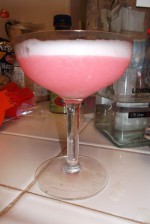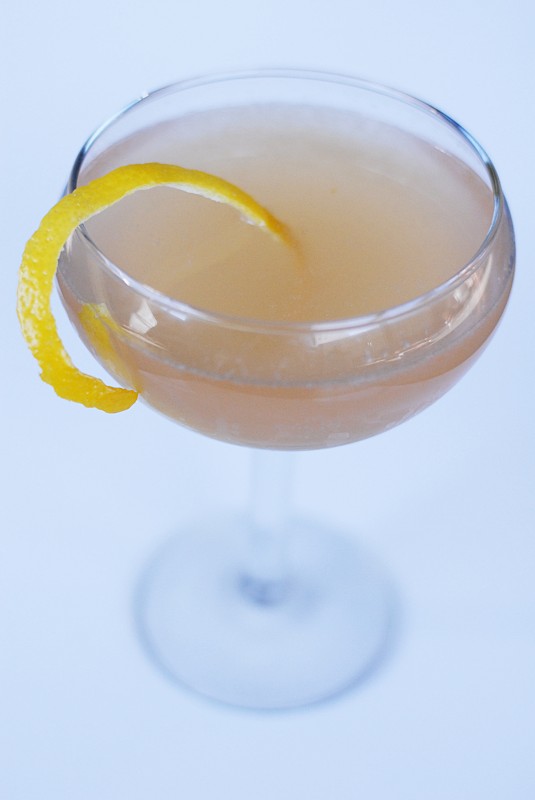Drink of the Week: The Clover Club (The Hess/Craddock Take, Modified)
 Sometimes the difference between one drink and another is miniscule. Take a Martini and put a cocktail onion in it instead of an olive or a lemon twist and it is miraculously transformed into a Gibson. On the other hand, recipes for the same basic cocktail can have vary so dramatically that you wonder how the results can even be compared, much less go under the same name.
Sometimes the difference between one drink and another is miniscule. Take a Martini and put a cocktail onion in it instead of an olive or a lemon twist and it is miraculously transformed into a Gibson. On the other hand, recipes for the same basic cocktail can have vary so dramatically that you wonder how the results can even be compared, much less go under the same name.
That’s what I’m realizing right now as I’ve been spending the week trying variations on a recipe I first found in Robert Hess’s 2008 The Essential Cocktail Guide and then found in Harry Craddock’s 1930 The Savoy Cocktail Book. Things got interesting when, too late for today’s post, I turned to my old pal Google and found that there is another version of today’s drink that might be a completely different taste experience entirely because of a difference in one key ingredient. I can’t dismiss it either because all signs point to it being every bit as much a classic, whatever that may mean, as today’s recipe. So, I guess we’ll have to revisit today’s drink again next week, except it won’t really be the same drink. Work, work, work.
In the meantime, here is my take on a drink which apparently goes back to a club for gentlemen — presumably no ladies allowed — in pre-Prohibition Philadelphia. As far as I’m concerned it’s a crime to deprive either gender of this liquid delight.
The Clover Club Cocktail (Craddock, Hess, Westal)
1 1/2 ounces gin
1/2 ounce fresh lemon juice or 3/4 ounce fresh lime juice
1/4 ounce grenadine
1 egg white
Combine all the ingredients in a cocktail shaker and shake without ice to properly emulsify the egg white. Then add ice and shake again to properly chill the concoction. Strain into a frosty-cold cocktail glass and toast the endless wonder and complexity of life and cocktails.
***
The Craddock recipe calls for the juice of 1/2 lemon or an entire lime — and goodness knows why bartenders in the day thought that was an acceptable instruction given the obvious reality that lemons and limes don’t all yield the exact same amount of juice. The vastly more recent Hess recipe calls for simply 3/4 of an ounce of lemon juice, but that came out a lot more tart than I like. It was time to play around with the proportions.
While using a mere 1/4 ounce lemon juice yielded too simple a drink, I found that 1/2 an ounce was darn nice. On the other hand, a full 3/4 ounce of less aggressively tart lime juice was the nicest of all. I could have gone for a slightly sweeter drink, but I found that cutting the lime juice down to 1/2 an ounce only resulted in a less lively beverage.
At least that’s what I thought. I certainly would never discourage anyone from adjusting the lemon or lime juice upwards or downwards to their taste. I will say, however, that you have to use some lemon or lime juice because, if you don’t, you’ll have a Pink Lady on your hands. I’m saving that one for some time when out of citrus completely.
You can follow us on Twitter and Facebook for content updates. Also, sign up for our email list for weekly updates and check us out on Google+ as well.

 Sometimes the hardest thing about writing and preparing for DOTW is simply picking out the drink. I can spend, it seems, many hours online trolling for a cocktail that won’t take hours to make and where I won’t have to spend an arm and a leg buying several expensive ingredients I barely have room for at stately DOTW Manor.
Sometimes the hardest thing about writing and preparing for DOTW is simply picking out the drink. I can spend, it seems, many hours online trolling for a cocktail that won’t take hours to make and where I won’t have to spend an arm and a leg buying several expensive ingredients I barely have room for at stately DOTW Manor. I sing now, for the umpteenth time, of the raw egg white, feared by many, adored by
I sing now, for the umpteenth time, of the raw egg white, feared by many, adored by  The French 75 does not refer to the number of pounds Gerard Depardieu could stand to lose. No, it refers to a really marvelous and relatively simple
The French 75 does not refer to the number of pounds Gerard Depardieu could stand to lose. No, it refers to a really marvelous and relatively simple 








